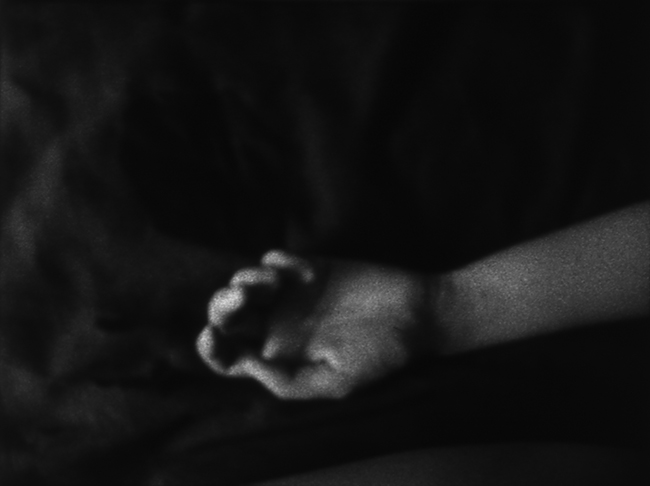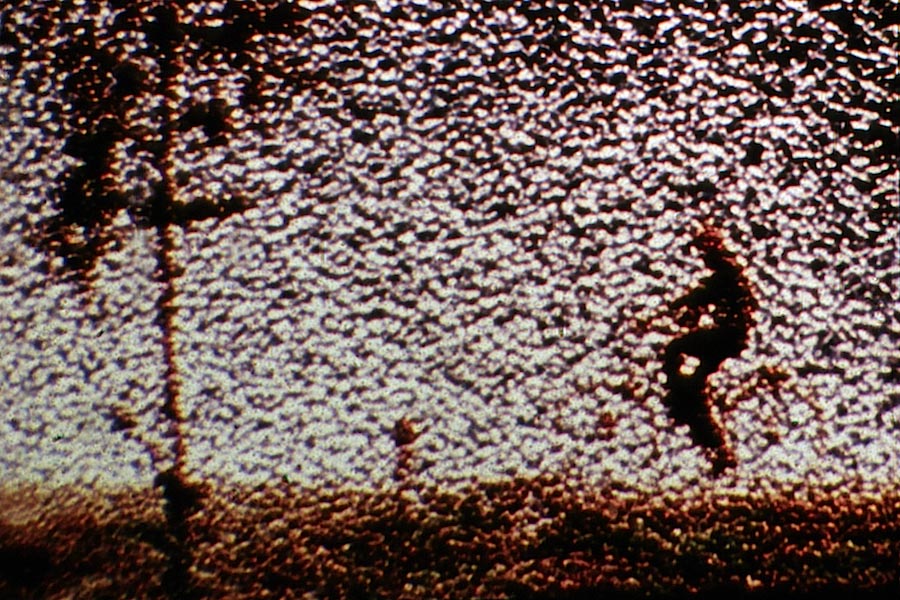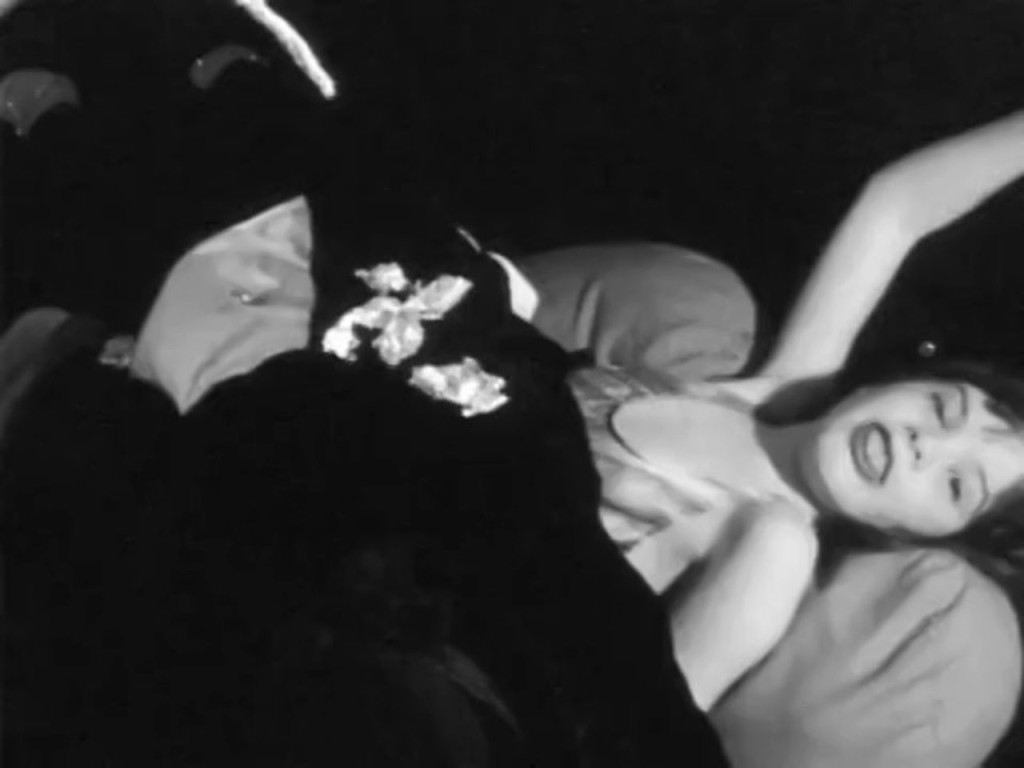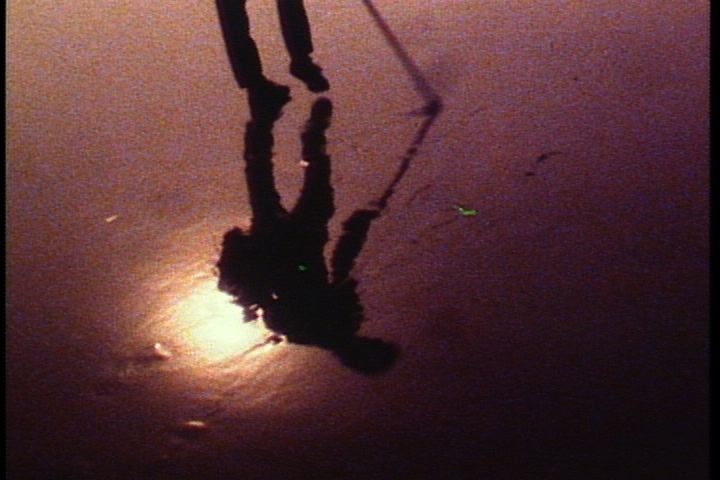October 19th, 2014
@ UT Austin, Doty Fine Arts Building, 2.204 (map)
7:00pm
Free!
***PLEASE NOTE: This screening will follow our 2014 edition of Home Movie Day at the Doty Fine Arts Building (click the map linke above). Free street parking is available just off campus along Dean Keeton and San Jacinto Blvd. Garage parking is available on campus in the San Jacinto parking garage, which has an entrance north of Doty Fine Arts on San Jacinto Blvd. Some fees apply. View location information and rate information for the San Jacinto parking garage. Parking for visitors with disabilities is available on campus in “D” spaces (see here), with required disability license plate or visible disabled person identification placard.***
“These films assert no vision of conquest, make no claims to hegemony. A minor cinema reshapes our image of the avant-garde, moving away from its image of shock troop battalions.” – Tom Gunning
The late 80s are a much discussed period in experimental film history: Fred Camper had published his controversial essay “The End of Avant-Garde Film”, and the contentious reception of the 1989 International Experimental Film Congress in Toronto brought a number of simmering issues to the fore. In response to these developments, Tom Gunning wrote “Towards a Minor Cinema: Fonoroff, Herwitz, Ahwesh, LaPore, Klahr, and Solomon”, where the film scholar saw a fresh proclivity among a group of filmmakers, many of them associated with the Massachusetts College of Art and Design. Citing a shift from the dominant modes of structural film and the new narrative, a use of small-gauge film in the age of analog video, and a celebration of “marginal identity, fashioning from it a revolutionary consciousness”, Gunning articulated a stance that continues to inspire moving image artists today.
In honor of Home Movie Day, Experimental Response Cinema and Mad Stork Cinema are excited to present a screening inspired by Gunning’s article, including several works on their original Super 8mm formats. Featuring films by Peggy Ahwesh, Nina Fonoroff, Peter Herwitz, Lewis Klahr, Saul Levine, Phil Solomon, and a brand-new print of Mark LaPore’s Five Bad Elements, recently restored by the Academy of Motion Pictures and Sciences. Copies of Tom Gunning’s article will also be available at the screening. Film prints courtesy of Canyon Cinema and the artists. Programmed by Ekrem Serdar.
![]() The Mad Stork Cinema is a student-run screening organization that brings beautiful, strange, and seldom-screened film and video works from the outskirts of experimental cinema to UT campus.
The Mad Stork Cinema is a student-run screening organization that brings beautiful, strange, and seldom-screened film and video works from the outskirts of experimental cinema to UT campus.
![]() Funding is provided by the University Co-Op.
Funding is provided by the University Co-Op.
![]() This project is funded and supported in part by the City of Austin through the Economic Growth & Redevelopment Services Office / Cultural Arts Division believing an investment in the Arts is an investment in Austin’s future. Visit Austin at NowPlayingAustin.com.
This project is funded and supported in part by the City of Austin through the Economic Growth & Redevelopment Services Office / Cultural Arts Division believing an investment in the Arts is an investment in Austin’s future. Visit Austin at NowPlayingAustin.com.
Program
Note to Pati by Saul Levine
8 min / 16mm / silent / 1969
“Note on snowstorms in February-March ’69. The restoration of the landscape begun to show friends on west coast violent beauty of this period. Childhood memories, snowball fights, sledding, etc., and how I felt about Medford where I live kept entering into the film. The principal birds in the film are the blue jay and the crow, both beautiful, smart and ruthless.” – Saul Levine
Restoration 16mm blows-ups of 8mm films by the National Film Preservation Foundation, Anthology Film Archives and BB Optics.
The Scary Movie by Peggy Ahwesh
9 min / 16mm / sound / 1993
“… THE SCARY MOVIE, by Peggy Ahwesh, [is an] amazingly complex (and just plain amazing) film informed by a wide range of issues and concerns, including feminism, psychoanalytic theory (especially Jacques Lacan), home-movie aesthetics, film genre conventions, and the notion of self-reflexivity in film. … [S]he plays with the Freudian concept (filtered through Lacan) of the female’s ‘lack’ of a penis, turning this core issue of psychoanalytic thinking on its head. … In [this] film it is the male who ‘lacks,’ men being conspicuously absent, even when the ‘narrative’ calls for male roles. … Ahwesh’s work … is notable in the way that it combines subjects of seriousness and gravity with an unparalleled control of the film medium, a disarming wit, and a frankness that catches one by surprise.” – Patrick Friel, Indianapolis Museum of Art
Lost Camel Intentions by Lewis Klahr
10 min / Super 8mm / sound / 1988
“In Lost Camel Intentions, the first film of his cycle Tales of the Forgotten Future, his skeleton protagonist journeys from a desert plane wreck to what appears to be a United States car dealership. Klahr’s black and white landscapes and the persistence of his main character through physical metamorphosis and geographic displacement offers a table-top odyssey of immigration and acculturation.
Beyond this archetypal ancestral legend, Lost Camel Intentions draws on adolescent masculine guilt and embarrassment. As soon as the skeleton gains flesh and escapes the desert, he gets a boner, ridiculously prominent as he walks the streets of an art deco city. But you can take the nomad out of the desert easier that you can root him in a new found home. Metaphorphosized into cut-out snapshots of Klahr’s grandfather, the protagonist dwells in a new world primarily composed of road maps. This world fills with automobiles which provide him with emblems of masculine potency, a site for erotic encounters, and, most importantly, the means of a quick get-away. Deflecting found images from the original univocality, Klahr maps out a fantasized past as well as a forgotten future, fraying the linearity of narrative into a netweork of metaphors, visuals puns and submerged primal scenes.” – Tom Gunning
Mysterious Barricades by Peter Herwitz
8 min / Super 8mm / silent / 1987
“A highly concentrated, ravishingly hand-manipulated film that evokes states of the sublime as well as loneliness and emotional turmoil. Made by Herwitz while he was a graduate student at the San Francisco Art Institute, this wholly original work is imbued with Saul Levine’s influence.” – Steve Anker
A Knowledge We Can Not Lose by Nina Fonoroff
17 min / Super 8mm / sound / 1989
“The film concerns the death of my father and the ways in which I was partially able to come to terms with his loss. It is largely about my effort to construct, through memory, an impression of how his life influenced mine and the lives of other people. There is footage of my father taken over the years, images of his handwriting in the form of his journals and letters I’d received from him, scenes of myself reading from his journals and footage shot from television. The soundtrack consists of diverse material: audiotapes that were recorded in my family when I was growing up, testimonials of people who had grown close to him in the last years of his life, Yiddish folk songs. I was obliged to search for and select traces of my father’s life from fragmentary evidence, never able to assemble a complete ‘portrait.’
The film is concerned with tensions that arise around the notions of fact versus fiction, truth versus falsification, and in making it I was dealing with the grieving process by experiencing the effect of looking at images of a person who is dead. The theme of a Jewish tradition is also central to the film, as conveyed through music and storytelling, and the idea that knowledge of a cultural tradition can be passed on from one generation to the next, but must necessarily be transformed in the process.” – Nina Fonoroff
“Her searching attitude suggests that with the loss of her father came a questioning of the role, not of a particular father, but the father figure – a refusal of authority, and an appreciation of her father’s cycles of learning, teaching, learning. As Danny Kaye, playing Hans Christian Andersen, tells a group of children the story of a piece of chalk that saw itself as the source, not the transmitter of knowledge, one senses Fonoroff’s sorrow at the loss inherent in the film image, and a yearning for the source of the image, not just its projection.” – Kathy Geritz, Pacific Film Archive
Awards: Grand Prize, Black Maria Film and Video Festival, 1989; First Prize, SF Art Institute Film Festival, 1990. Shown on “Independent Focus,” WNET-TV, NY.
Remains to be Seen by Phil Solomon
17:30 min / Super 8mm / sound / 1989/1994
“Using chemical and optical treatments to coat the film with a limpid membrane of swimming crystals, coagulating into silver recall, then dissolving somewhere between the Operating Theatre, The Waterfall, and the Great Plains.” – Phil Solomon
“In the melancholic REMAINS TO BE SEEN, dedicated to the memory of Solomon’s mother, the scratchy rhythm of a respirator intones menace. The film, optically crisscrossed with tiny eggshell cracks, often seems on the verge of shattering. The passage from life into death is chartered by fugitive images: pans of an operating room, an old home movie of a picnic, a bicyclist in vague outline against burnt orange and blue …. Solomon measures emotions with images that seem stolen from a family album of collective memory.” – Manohla Dargis, The Village Voice
Top Ten Films of 1989, The Village Voice; First Prize, Oberhausen Film Festival (1989)
Five Bad Elements by Mark LaPore
32 min / 16mm / sound / 1997
NEW PRINT from Academy Film Archive – 2014!
“A filmic Pandora’s Box full of my version of ‘trouble’ (death, loss, cultural imperialism) as well as the trouble with representation as incomplete understanding.” – Mark LaPore
A dark and astringent film that allows the filmmaker’s personal subconscious drives and the equivocal bad conscience of ethnography to bleed through into overt content. In several of his previous films (Depression in the Bay of Bengal and The Sudan Rolls) LaPore applied inspiration received from the early cinema of the Lumiere brothers allowing the integrity of the shot and the long take to convey a sense of continuing development. We witness discrete unfoldings of small narratives and performative processes of labor or unconscious movement that carry the tell tale symptoms of cultural transitions. There is also a heightened and uncanny sense of ordinariness (perhaps most strongly felt in LaPore’s work in progress 100 Views of New York) seen with a tweaked awareness of instability and evanescence, the knowledge that the present has no permanent residence, the contemporary is in continuous eviction.
The serendipitous orchestration of the world composing itself in time within the domain of the fixed frame is set in a delicate equipoise with the sensibility and organizing vision of the filmmaker. With his exquisite observational acuity (visual, anthropological, sociological) and formal severity LaPore’s approach aspires to a kind of rich transparency. Poetically decisive compositions open up the impedance in the flow and transference of the fabric of the real as it passes away into photochemical illusion. LaPore is expanding a tradition of experimental documentary filmmaking practiced by Calvacanti, Wright, Rouch, Gardener, the Macdougals, Hutton and Gehr, conducting profoundly cinematic, highly distilled personal investigations into the nature of cultural flux and reverie.
The hand held camerawork and the particular leverage of The Five Bad Elements both pushes and works against LaPore’s previous tendencies in order to create compound fractures of potent abbreviations – seemingly dislocated images uncategorically taken and placed into ‘improper’ contexts, severed from a mappable space or geography – and overextended, unexpurgated scenes in which sight is caught actively probing or transfixed in seeming paralysis. By interrupting already truncated and mysteriously unmoored images with sections prolonging the durations and decay time of images normally torn from our sight, LaPore offers not provocation or obsession as much as permission to travel deeper into the image. The image as it pertains to actual experience – not only a filmic event or an approximate residue that stands in for something else as all images do. Refusing to satisfy curiosity with information, LaPore frustrates the usual complicities between image and documentary fact by dealing with representation as an execution of likeness, while still reckoning with the standard exchange rate of the image in its metaphoric fidelity to the real, the elusive and the tangible aspects of the image. LaPore’s audacities are almost camouflaged by his refined sense of restraint, his austerity and lyrical contemplativeness.
The title of the film is mischievously cribbed from a gang of troublemakers that appears in Chinese filmmaker Xie Jin’s film Hibiscus Town but also hints at the biblical concept of The Seven Deadly Sins, of universal ingredients – the four elements – earth, water, air and fire. Bad elements can refer euphemistically to a criminal milieu, “the wrong crowd,” as well as suggesting the antiquated medical notion of the circulating ‘humors’ that govern disposition and health. Going to the source of trouble was part of the filmmakers intent. LaPore: ‘I was more interested in who put those things into Pandora’s box than I was in who let them out.’ In short the film is concerned with notions of basic and invasive influences, economy and eros, the rudiments of human composition, human error and the transgressive. Elements quietly attempts a suspect and perilous curative measure akin to bloodletting. ‘Key’ evidence is spilled along with what would normally be suppressed or discounted as tangential. By exhibiting its own undercurrents and letting them hold sway, Elements thwarts commitment to documentary obligations which would prohibit its strangely moving and tainted disclosures. If we are used to works of transgression announcing themselves as such and then flamboyantly misbehaving as spectacular and bracing ‘entertainments,’ LaPore’s move to a higher level of accomplishment could catch us off guard or seem oblique. Sound and image are subtly and rigorously counterpointed so as to fall into unnatural relations, blistering as they graze against each other and leaving a stinging afterglow of synesthesia and emotional voltage. By building the film on normally inadmissible evidence, telegraphed inferences, metaphoric leaps and omissions, damaged testimonies and scattered remains the film fabricates an impeccable and elegant architecture from a materially incomplete and unsound body. In the fragmented corpus of human beings and continents which is The Five Bad Elements, LaPore has created a film which itself acts as an absorbent object, a kind of metastatic sin eater that aims at expiation through its own contamination, redistributing poisons into a netherworld that still clearly resides at the core of its own physical and visible existence. -Mark McElhatten
Exhibition: Millennium Opium Den Group Show, NY, 1992*; Opium Den Group Show, NY, 1993*; Burning in the Gate, American Museum of the Moving Image, NY, 1994*; NY Film Festival, NY, 1997.



